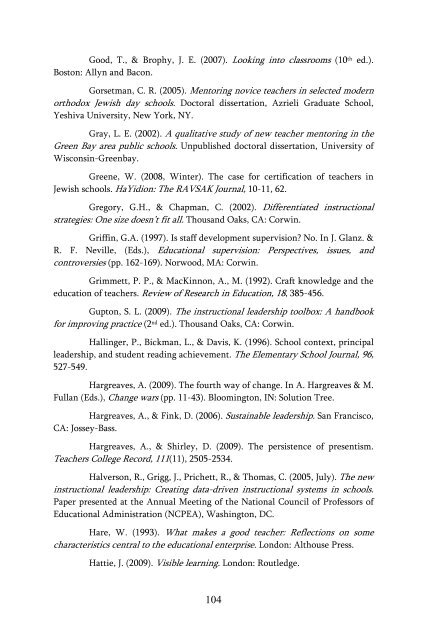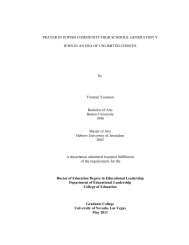Good, T., & Brophy, J. E. (2007). Look<strong>in</strong>g <strong>in</strong>to classrooms (10 th ed.).Boston: Allyn <strong>and</strong> Bacon.Gorsetman, C. R. (2005). Mentor<strong>in</strong>g novice teachers <strong>in</strong> selected modernorthodox <strong>Jewish</strong> day schools. Doctoral dissertation, Azrieli Graduate School,Yeshiva University, New York, NY.Gray, L. E. (2002). A qualitative study of new teacher mentor<strong>in</strong>g <strong>in</strong> theGreen Bay area public schools. Unpublished doctoral dissertation, University ofWiscons<strong>in</strong>-Greenbay.Greene, W. (2008, W<strong>in</strong>ter). The case for certification of teachers <strong>in</strong><strong>Jewish</strong> schools. HaYidion: The RAVSAK Journal, 10-11, 62.Gregory, G.H., & Chapman, C. (2002). Differentiated <strong>in</strong>structionalstrategies: One size doesn’t fit all. Thous<strong>and</strong> Oaks, CA: Corw<strong>in</strong>.Griff<strong>in</strong>, G.A. (1997). Is staff development supervision? No. In J. Glanz. &R. F. Neville, (Eds.), Educational supervision: Perspectives, issues, <strong>and</strong>controversies (pp. 162-169). Norwood, MA: Corw<strong>in</strong>.Grimmett, P. P., & MacK<strong>in</strong>non, A., M. (1992). Craft knowledge <strong>and</strong> theeducation of teachers. Review of Research <strong>in</strong> Education, 18, 385-456.Gupton, S. L. (2009). The <strong>in</strong>structional leadership toolbox: A h<strong>and</strong>bookfor improv<strong>in</strong>g practice (2 nd ed.). Thous<strong>and</strong> Oaks, CA: Corw<strong>in</strong>.Hall<strong>in</strong>ger, P., Bickman, L., & Davis, K. (1996). School context, pr<strong>in</strong>cipalleadership, <strong>and</strong> student read<strong>in</strong>g achievement. The Elementary School Journal, 96,527-549.Hargreaves, A. (2009). The fourth way of change. In A. Hargreaves & M.Fullan (Eds.), Change wars (pp. 11-43). Bloom<strong>in</strong>gton, IN: Solution Tree.Hargreaves, A., & F<strong>in</strong>k, D. (2006). Susta<strong>in</strong>able leadership. San Francisco,CA: Jossey-Bass.Hargreaves, A., & Shirley, D. (2009). The persistence of presentism.Teachers College Record, 111(11), 2505-2534.Halverson, R., Grigg, J., Prichett, R., & Thomas, C. (2005, July). The new<strong>in</strong>structional leadership: Creat<strong>in</strong>g data-driven <strong>in</strong>structional systems <strong>in</strong> schools.Paper presented at the Annual Meet<strong>in</strong>g of the National Council of Professors ofEducational Adm<strong>in</strong>istration (NCPEA), Wash<strong>in</strong>gton, DC.Hare, W. (1993). What makes a good teacher: Reflections on somecharacteristics central to the educational enterprise. London: Althouse Press.Hattie, J. (2009). Visible learn<strong>in</strong>g. London: Routledge.104
Hattie, J., & Timperley, H. (2007). The power of feedback. Review ofEducational Research, 77, 81-112.Hayes, R., & Matusov, E. (2005). Design<strong>in</strong>g for dialogue <strong>in</strong> place ofteacher talk <strong>and</strong> student silence. Culture <strong>and</strong> Psychology, 11(3), 339-357.Hayman, P. (1997). On the teach<strong>in</strong>g of the Talmud: Toward amethodological basis for curriculum <strong>in</strong> oral tradition studies. ReligiousEducation, 92(1), 61-76.Heck, R. H. (2007). Exam<strong>in</strong><strong>in</strong>g the relationship between teacher qualityas an organizational property of schools <strong>and</strong> students’ achievement <strong>and</strong> growthrates. Educational Adm<strong>in</strong>istration Quarterly, 43(4), 399-432.Hedrick, K. A. (2005). Staff development for differentiation must bemade to measure. Journal of Staff Development, 26(4), 32-37.Hoetker, J., & Ahlbr<strong>and</strong>, W. P., Jr. (1969). The persistence of therecitation. American Education Research Journal, 6, 145-167.Holcomb, J. H. (1994). To tra<strong>in</strong> or to educate? International Journal ofEducational Management, 8(2), 37.Holl<strong>and</strong>, P. E., & Adams, P. (2002). Through the horns of a dilemmabetween <strong>in</strong>structional supervision <strong>and</strong> the summative evaluation of teach<strong>in</strong>g.International Journal of Leadership <strong>in</strong> Education, 5(3), 227-248.Holtz, B. W., Dorph, G. Z., & Goldr<strong>in</strong>g, E. B. (1997). Educational leadersas teacher educators: The Teacher Educator Institute: A case from <strong>Jewish</strong>education. Peabody Journal of Education, 72(2), 147-166.Hord, S. M., Rouss<strong>in</strong>, J. L., & Sommers, W. A. (2009). Guid<strong>in</strong>gprofessional learn<strong>in</strong>g communities. Thous<strong>and</strong> Oaks, CA: Corw<strong>in</strong>.Horng, E. L., Klasik, D., & Loeb, S. (2010). Pr<strong>in</strong>cipals’ time use <strong>and</strong>school effectiveness. American Journal of Education, 116(4), 491-523.House, R. J. (1976). A theory of charismatic leadership. In J. G. Hunt &L. L.Larson, (Eds.), Leadership: The cutt<strong>in</strong>g edge (pp. 189-207). Carbondale:Southern Ill<strong>in</strong>ois University Press.Hunefeld, R. (2009). When teachers are the experts: How schools canimprove professional development. Education Week, 29(10), 24-25.<strong>Jewish</strong> Education Service of North America. (2008). Educators <strong>in</strong> <strong>Jewish</strong>schools study. New York: Author.Ji, P., Segawa, E., Burns, J., Campbell, R. T., Allred, C. G., & Flay, B. R.(2003). A measurement model of student character as described by the PositiveAction program. Journal of Research <strong>in</strong> Character Education, 3(2), 109-120.105
- Page 1 and 2:
Improving InstructionalQuality in J
- Page 4 and 5:
Appendix C: Assessing Your Role as
- Page 6 and 7:
others, involved in a cognate enter
- Page 8 and 9:
Weissberg, Walberg, & Wang., 2004).
- Page 10 and 11:
all. “We are never asked for what
- Page 12 and 13:
administrator. He was well-organize
- Page 14 and 15:
Sartoris, DiPrima Bickel, & Garnier
- Page 16 and 17:
grade conferences, etc., effective
- Page 18 and 19:
school’s teaching practices, the
- Page 20 and 21:
een made in the areas of science an
- Page 22 and 23:
learning is more likely to occur th
- Page 24 and 25:
content, and the need to ensure tha
- Page 26 and 27:
pattern.] I didn’t really realize
- Page 28 and 29:
constraints, increase in administra
- Page 30 and 31:
The Transformational Change Project
- Page 32 and 33:
that are not strategic, but episodi
- Page 34 and 35:
my personal involvement in work wit
- Page 36 and 37:
schools to even greater levels of s
- Page 38 and 39:
was: “Well, you know, finding tim
- Page 40 and 41:
called direct teaching), although e
- Page 42 and 43:
surprised when no one can answer
- Page 44 and 45:
RecommendationsI. Teaching1. Teache
- Page 46 and 47:
standards,” a significant opportu
- Page 48 and 49:
decide on an area or theme they’d
- Page 50 and 51:
• Reflective journaling - Another
- Page 52 and 53:
3. Deep instructional improvement v
- Page 54 and 55:
Instructional leadership is about e
- Page 56 and 57:
76). Teachers who employ instructio
- Page 58 and 59:
short answers to two questions. The
- Page 60 and 61: may become involved in cooperative
- Page 62 and 63: utilized within a differentiated le
- Page 64 and 65: Research-Based Teaching Practices i
- Page 66 and 67: curriculum? Schools, in my view, to
- Page 68 and 69: learning objectives have been ident
- Page 70 and 71: Developing curriculum at the planni
- Page 72 and 73: 4) Emphasize both the academic and
- Page 74 and 75: An Overview of Best Practices in Su
- Page 76 and 77: with practices best suited to promo
- Page 78 and 79: dialogue and meaningful supervision
- Page 80 and 81: • Ongoing - Too much of professio
- Page 82 and 83: to do so. In fact, utilizing in-sch
- Page 84 and 85: greatly to meaningful supervision a
- Page 86 and 87: and amplified by James MacGregor Bu
- Page 88 and 89: Leadership is predicated on the fou
- Page 90 and 91: Citing Jim Collins (2002 cited by F
- Page 92 and 93: Notes1. Before continuing, I sugges
- Page 94 and 95: ubric of “professional developmen
- Page 96 and 97: throughs, explains that according t
- Page 98 and 99: members are not fully cognizant or
- Page 100 and 101: AcknowledgementsI thank all the ind
- Page 102 and 103: Bass, B. M. (1985). Leadership and
- Page 104 and 105: Burke, P. J., & Krey, R. D. (2005).
- Page 106 and 107: Downey, C. J., Steffy, B. E., Posto
- Page 108 and 109: Fullan, M. (2005). Leadership and s
- Page 112 and 113: Johnson, C. C., & Fargo, J. D. (201
- Page 114 and 115: Marzano, R. J., & Brown, J. L. (200
- Page 116 and 117: Popham, W. J. (2008a). Classroom as
- Page 118 and 119: Shapira-Lishchinsky, O. (2009). Isr
- Page 120 and 121: Tschannen-Moran, M., & McMaster, P.
- Page 122 and 123: Annotated Works on Instructional Le
- Page 124 and 125: This volume is an inspiring introdu
- Page 126 and 127: you want to learn how to teach stud
- Page 128 and 129: AppendicesAppendix A: Instructional
- Page 130 and 131: Suggested responses:1. To be effect
- Page 132 and 133: Appendix C: Assessing Your Role as
- Page 134 and 135: SA A D SD 3. My spoken language as
- Page 136 and 137: Domain 2: The Classroom Environment
- Page 138 and 139: SA A D SD 13. I have a well-defined
- Page 140 and 141: SA A D SD 13. I rarely desire to se
- Page 142 and 143: 20. This is a well managed school.
- Page 144 and 145: Appendix F: Teacher Attitude Questi
- Page 146: 41. My colleagues and I usually dis










